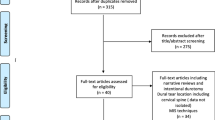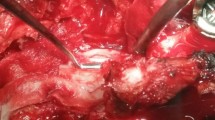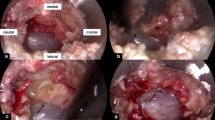Abstract
Background
The intra- and postoperative management of accidental durotomy in operations of the lumbar spine is not standardized. It is the aim of our survey to obtain an overview on the current practice in neurosurgical departments in Germany.
Methods
The used questionnaire consisted of three questions and could be answered within a few minutes by checking boxes. In September 2012, the questionnaire was sent to 149 German neurosurgical departments. In the following 4 weeks 109 replies (73.2 %) were received.
Results
Seventy-one neurosurgical departments (65.1 %) treat dural tears by a combination of methods, 28 (25.7 %) with suture alone, 7 (6.4 %) with fibrin-coated fleeces alone, 2 (1.8 %) with muscle patch alone and 1 (0.9 %) with fibrin glue alone. Sixty-six neurosurgical departments (60.5 %) decide on postoperative bed rest depending on the quality of the dural closure. Forty-three (39.5 %) neurosurgical departments do not rely on the quality of the dural closure for their postoperative management. In total, 72.5 % of the neurosurgical departments prescribe bed rest for 1–3 days, 1.8 % for more than 3 days, whereas 25.7 % allow immediate mobilization.
Conclusions
Among German neurosurgeons, no consensus exists concerning the intra- and postoperative management of accidental durotomies in lumbar spine surgery. Despite not being proved to reduce the rate of cerebrospinal fluid fistulas, bed rest is frequently used. As bed rest prolongs the hospital stay with additional costs and has the potential of a higher rate of medical complications, a prospective multicenter trial is warranted.
Similar content being viewed by others
Avoid common mistakes on your manuscript.
Introduction
Dural lesions are one of the most common complications in lumbar spine surgery. They might be associated with minor sequelae such as low-pressure headache, nausea, vomiting, dizziness and vertigo [16, 21]. More severe sequelae are cerebrospinal fluid (CSF) fistulas, wound healing disturbances, meningitis, pseudomeningoceles and subdural hematomas [8, 14]. The prevalence is described to be between 1.8 % and 17.4 % [5, 9, 15, 26, 27, 29, 30], rising with the patient’s age, complexity of the operation and revision operations. Even so, surgeons tend to underestimate the frequency of accidental durotomies [28].
The present literature describes different strategies for intraoperative closure of “common” dural tears with CSF flow. Suture alone, application of fibrin glue, epidural blood patches and different combinations of suture, fibrin glue and patches with or without a temporary lumbar drain have been suggested for dural closure [2, 4, 7, 9, 11, 12, 18, 22, 23]. However, evidence-based data are missing. The same holds true for the postoperative management. Bed rest is frequently recommended, but the proof is lacking that bed rest reduces the rate of CSF fistulas and reoperations [3, 9, 15, 29]. Therefore, others refrain from prescribing bed rest [7, 13].
The common practice in the management of accidental durotomies with CSF flow in the lumbar spine in Germany is not known. The inconsistency of recommendations in the literature suggests that the management is not uniform. It is the aim of the present nationwide survey to obtain data on the intra- and postoperative management of accidental durotomies.
Methods and materials
A survey was sent to all German neurosurgical departments. The survey aimed to investigate the departments' daily practice in “common” accidental dural tears in lumbar spinal surgery, such as discectomy, laminotomy, laminectomy and fusion. Elucidating the practice in specifically difficult cases, such as extensive dural lacerations with or without neurological damage, was considered to be beyond the scope of a survey. Assuming that a neurosurgical department has defined a standard operating procedure for iatrogenic dural tears, only the heads of the departments and not the individual staff members were contacted. Neurosurgeons in private practice and orthopedic spine surgeons were not included.
We used a brief, clearly structured survey consisting of three questions (attached in the Appendix) to increase the chance of a high response rate and to obtain reliable and comparable data for statistical analysis. Every question was easy to answer by checking boxes. The multiple-choice character of the survey was chosen to obtain a structured overview of the different applied therapies. Nevertheless, comments could be added if wanted. The first question addressed the intraoperative management of accidental durotomies and asked whether tears are closed by suture alone, fibrin glue alone or a combination. The second question referred to the postoperative management. We wanted to know if patients are kept in bed for 1–3 days, for more than 3 days or if they were mobilized immediately after surgery. The third question asked if the decision for or against bed rest depends on the quality of intraoperative dural closure.
Results
In September 2012, the survey was sent to all 149 neurosurgical departments in Germany. In the following weeks, we received 109 answers, corresponding to a response rate of 73.2 %.
Seventy-one of the 109 neurosurgical departments (65.1 %) routinely use a combination of different methods and materials for closing a dural tear (Fig. 1). Of these 71 departments, 43 (60.6 %) use suture and a fibrin-coated fleece, 6 (8.5 %) suture plus fibrin glue, 3 (4.2 %) suture, muscle patch and fibrin glue, 3 (4.2 %) suture, muscle patch and fibrin-coated fleece, 2 (2.8 %) a combination of suture, fat patch and glue, and another 2 (2.8 %) a combination of suture, fibrin-coated fleece and glue. Combinations of suture plus muscle patch or fat patch plus fibrin glue are used in one neurosurgical department, respectively (1.4 %). Ten neurosurgical departments (14.1 %) did not explain their combination methods in detail or mention that the decision is made individually. Eight different combinations were compiled in total (Table 1).
Twenty-eight of the 109 neurosurgical departments (25.7 %) routinely close the dural tear by suture alone, 7 (6.4 %) by a fibrin-coated fleece alone, 2 (1.8 %) by muscle/fat patch alone and 1 (0.9 %) by fibrin glue alone. Altogether, at least 81.7 % of the neurosurgical departments use sutures for dural closure either alone or in combination. Sixty-eight of the 109 departments (62.4 %) explicitly mentioned modifying the hospital’s standard procedure for dural closure in specific cases.
In 66 departments (60.5 %), the quality of the dural closure determines (the days of) postoperative bed rest (Fig. 2). If the neurosurgeons opted for bed rest, 45 neurosurgical departments (68.2 %) immobilize the patient for 1–3 days and 2 (3 %) for more than 3 days. Nineteen of these neurosurgical departments (28.8 %) allow immediate mobilization.
Forty-three of the 109 neurosurgical departments (39.5 %) follow a general, nonindividual management. Thirty-five departments (81.4 %) immobilize patients with intraoperative dural tears for 1–3 days. Eight departments (18.6 %) treat patients with and without dural tear identically with immediate mobilization.
In total, 79 neurosurgical departments (72.5 %) immobilize patients with intraoperative dural tear for 1–3 days (Fig. 3) and 2 (1.8 %) for more than 3 days. Only 28 neurosurgical departments (25.7 %) allow unrestricted postoperative mobilization.
Discussion
Accidental durotomy represents the most common complication in lumbar spine surgery. Nonetheless, no consensus on the best management of this complication exists. To gain baseline information on the common practice in German neurosurgical departments, the survey was initiated. With 73.2 %, the response rate is high and the results could be considered to be truly representative for German neurosurgical departments.
Dural closure
Obviously, the size and exact location of the dural tear, fragility of the dura and invasiveness of the approach (with CSF leakages possibly being less frequent in minimally invasive spine procedures) guide the intraoperative management of the dural lesion [6, 19]. However, we asked for the management of the “common” dural tear, which has an incidence of 1.8 % to 7.6 % [9, 26] in primary spinal operations. Nonetheless, the methods of dural closure vary tremendously in German neurosurgical departments (at least 12 different managements in 109 departments), which reflects that in the absence of scientific evidence a particular surgeon’s feeling and personal experiences guide decision making. One might assume that, analogous to cranial neurosurgery, watertight dural closure, if achieved by sutures alone, would be considered sufficient for CSF leakage prevention, especially if a Valsalva maneuver proved water tightness [3, 32]. However, the majority of German neurosurgeons do not trust sutures alone but combine them with either fibrin-coated fleeces or fibrin glue despite the fact that these materials are expensive, the fibrinolytic potential of CSF degradates fibrin glue within days [31] and no randomized trial has ever shown that they indeed further reduce the risk of CSF leakage.
Postoperative bed rest
The lumbosacral intrathecal pressure in the standing position is higher than the intracranial pressure, which might explain why the majority of German neurosurgeons immobilize patients with dural tears either routinely or if the dural closure was considered to be of minor quality for 1–3 days. This management is in line with several studies. Khan et al. [9] observed incidental durotomies in 338 of 3,183 lumbar spine operations. After bed rest for at least 24 h, the patients were gradually mobilized. Six of the 338 patients (1.8 %) required revision surgery. In another prospective single-center study [15], 102 patients with intraoperatively detected and repaired dural tears were immobilized for 2 days. Seven patients (6.9 %) required revision surgery. In the literature review of Bosacco et al. [3], “long-term supination” for up to 10 days was proposed. The authors assumed but did not prove that the need for revision surgery is lower.
A few publications propose immediate mobilization despite a dural tear. Hodges et al. [7] described the results of immediate postoperative mobilization in 20 patients sustaining dural tears in lumbar spine surgery. Seventy-five percent of patients did not have any symptom in the postoperative course, 10 % each complained of headaches and nausea, and one patient (5 %) required revision surgery. Ruban and O’Toole [19] allowed 53 patients with sutured or glued dural tears during minimally invasive spine surgery to ambulate the morning after surgery. No CSF fistula or pseudomeningocele was observed. Only one patient (1.9 %) required revision surgery, but for a superficial wound infection. The recently published retrospective study by Low et al. [13], including 61 patients with incidental durotomy in lumbar spine surgery, showed no increase in complications in the 26 patients who were mobilized immediately.
Comparing series with and without bed rest after accidental durotomy, the rate of revision surgeries is not higher in patients not kept in bed. Nonetheless, only the minority of German neurosurgeons believes that immobilization of patients with accidental durotomy in spinal surgery is superfluous.
Immobilization increases the risk of deep vein thrombosis, pulmonary embolism [1, 20, 24, 25] and pneumonia [10, 17]. Furthermore, immobilization prolongs the length of the hospital stay and thereby increases the costs. A higher medical complication rate and higher costs are only justified if the rate of revision surgeries is indeed substantially reduced by immobilization. Thus, a study comparing early mobilization with immobilization in patients experiencing dural damage during spine surgery is needed.
Conclusion
In German neurosurgical departments, the intra- and postoperative management of the “common” accidental dural tear in lumbar spine surgery is far from being standardized. In the absence of publications with a high evidence level, the decisions on how to close the dura and how to mobilize the patient after surgery are obviously guided by personal experiences. In contrast to cranial neurosurgery, a combination of methods and materials is used for dural closure in lumbar spine surgery by the majority of German neurosurgeons. Likewise, a majority postoperatively immobilizes the patient for 1–3 days either routinely or depending on the assumed efficacy of the dural closure. As immobilization is related to more medical complications and higher costs, a prospective randomized trial is warranted.
References
Anderson FA Jr, Spencer FA (2003) Risk factors for venous thromboembolism. Circulation 107:I9–I16
Black P (2002) Cerebrospinal fluid leaks following spinal surgery: use of fat grafts for prevention and repair. Technical note. J Neurosurg 96:250–252
Bosacco SJ, Gardner MJ, Guille JT (2001) Evaluation and treatment of dural tears in lumbar spine surgery: a review. Clin Orthop Relat Res 389:238–247
Cain JE Jr, Dryer RF, Barton BR (1988) Evaluation of dural closure techniques. Suture methods, fibrin adhesive sealant, and cyanoacrylate polymer. Spine (Phila Pa 1976) 13:720–725
Cammisa FP Jr, Girardi FP, Sangani PK, Parvataneni HK, Cadag S, Sandhu HS (2000) Incidental durotomy in spine surgery. Spine (Phila Pa 1976) 25:2663–2667
Chou D, Wand VY, Khan AS (2009) Primary dural repair during minimally invasive microdiscectomy using standard operating room instruments. Neurosurgery 64:356–358, discussion 358–359
Hodges SD, Humphreys SC, Eck JC, Covington LA (1999) Management of incidental durotomy without mandatory bed rest. A retrospective review of 20 cases. Spine (Phila Pa 1976) 24:2062–2064
Huh J (2013) Burr hole drainage: could be another treatment option for cerebrospinal fluid leakage after unidentified dural tear during spinal surgery? J Korean Neurosurg Soc 53:59–61
Khan MH, Rihn J, Steele G, Davis R, Donaldson WF 3rd, Kang JD, Lee JY (2006) Postoperative management protocol for incidental dural tears during degenerative lumbar spine surgery: a review of 3,183 consecutive degenerative lumbar cases. Spine (Phila Pa 1976) 31:2609–2613
Kim KD, Chang CH, Choi BY, Jung YJ (2014) Mortality and real cause of death from the nonlesional intracerebral hemorrhage. J Korean Neurosurg Soc 55:1–4
Kitchel SH, Eismont FJ, Green BA (1989) Closed subarachnoid drainage for management of cerebrospinal fluid leakage after an operation on the spine. J Bone Joint Surg Am 71:984–987
Lauer KK, Haddox JD (1992) Epidural blood patch as treatment for a surgical durocutaneous fistula. J Clin Anesth 4:45–47
Low JC, von Niederhäusern B, Rutherford SA, King AT (2013) Pilot study of perioperative accidental durotomy: does the period of postoperative bed rest reduce the incidence of complication? Br J Neurosurg 27:800–802
Lu CH, Ho ST, Kong SS, Cherng CH, Wong CS (2002) Intracranial subdural hematoma after unintended durotomy during spine surgery. Can J Anaesth 49:100–102
McMahon P, Dididze M, Levi AD (2012) Incidental durotomy after spinal surgery: a prospective study in an academic institution. J Neurosurg Spine 17:30–36
Mokri B, Piepgras DG, Miller GM (1997) Syndrome of orthostatic headaches and diffuse pachymeningeal gadolinium enhancement. Mayo Clin Proc 72:400–413
Pakzad H, Roffey DM, Knight H, Dagenais S, Yelle JD, Wai EK (2011) Delay in operative stabilization of spine fractures in multitrauma patients without neurologic injuries: effects on outcomes. Can J Surg 54:270–276
Patel MR, Louie W, Rachlin J (1996) Postoperative cerebrospinal fluid leaks of the lumbosacral spine: management with percutaneous fibrin glue. AJNR Am J Neuroradiol 17:495–500
Ruban D, O’Toole JE (2011) Management of incidental durotomy in minimally invasive spine surgery. Neurosurg Focus 31:E15
Samama MM, Dahl OE, Quinlan DJ, Mismetti P, Rosencher N (2003) Quantification of risk factors for venous thromboembolism: a preliminary study for the development of a risk assessment tool. Haematologica 88:1410–1421
Schievink WI, Meyer FB, Atkinson JL, Mokri B (1996) Spontaneous spinal cerebrospinal fluid leaks and intracranial hypotension. J Neurosurg 84:598–605
Shaffrey CI, Spotnitz WD, Shaffrey ME, Jane JA (1990) Neurosurgical applications of fibrin glue: augmentation of dural closure in 134 patients. Neurosurgery 26:207–210
Shapiro SA, Scully T (1992) Closed continuous drainage of cerebrospinal fluid via a lumbar subarachnoid catheter for treatment or prevention of cranial/spinal cerebrospinal fluid fistula. Neurosurgery 30:241–245
Spyropoulos AC (2010) Risk assessment of venous thromboembolism in hospitalized medical patients. Curr Opin Pulm Med 16:419–425
Spyropoulos AC, Anderson FA Jr, Fitzgerald G, Decousus H, Pini M, Chong BH, Zotz RB, Bergmann JF, Tapson V, Froehlich JB, Monreal M, Merli GJ, Pavanello R, Turpie AG, Nakamura M, Piovella F, Kakkar AK, Spencer FA, Investigators IMPROVE (2011) Predictive and associative models to identify hospitalized medical patients at risk for VTE. Chest 140:706–714
Stolke D, Sollmann WP, Seifert V (1989) Intra- and postoperative complications in lumbar disc surgery. Spine (Phila Pa 1976) 14:56–59
Strömqvist F, Jönsson B, Strömqvist B, Swedish Society of Spinal Surgeons (2012) Dural lesions in decompression for lumbar spinal stenosis: incidence, risk factors and effect on outcome. Eur Spine J 21:825–828
Tafazal SI, Sell PJ (2005) Incidental durotomy in lumbar spine surgery: incidence and management. Eur Spine J 14:287–290
Wang JC, Bohlmann HH, Riew KD (1998) Dural tears secondary to operations on the lumbar spine. Management and results after a two-year-minimum follow-up of eighty-eight patients. J Bone Joint Surg Am 80:1728–1732
Weinstein JN, Lurie JD, Tosteson TD, Tosteson AN, Blood EA, Abdu WA, Herkowitz H, Hilibrand A, Albert T, Fischgrund J (2008) Surgical versus nonoperative treatment for lumbar disc herniation: four-year results for the Spine Patient Outcomes Research Trial (SPORT). Spine (Phila Pa 1976) 33:2789–2800
Whitelaw A, Mowinckel MC, Fellman V, Abildgaard U (1996) Endogenous tissue plasminogen activator in neonatal cerebrospinal fluid. Eur J Pediatr 155:117–119
Wolff S, Kheirredine W, Riouallon G (2012) Surgical dural tears: prevalence and updated management protocol based on 1359 lumbar vertebra interventions. Orthop Traumatol Surg Res 98:879–886
Conflicts of interest
None.
Author information
Authors and Affiliations
Corresponding author
Appendix
Appendix

Rights and permissions
About this article
Cite this article
Clajus, C., Stockhammer, F. & Rohde, V. The intra- and postoperative management of accidental durotomy in lumbar spine surgery: results of a German survey. Acta Neurochir 157, 525–530 (2015). https://doi.org/10.1007/s00701-014-2325-0
Received:
Accepted:
Published:
Issue Date:
DOI: https://doi.org/10.1007/s00701-014-2325-0







